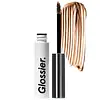What's inside
What's inside
 Key Ingredients
Key Ingredients

 Benefits
Benefits

 Concerns
Concerns

 Ingredients Side-by-side
Ingredients Side-by-side

Octyldodecanol
EmollientDipentaerythrityl Hexahydroxystearate/Hexastearate/Hexarosinate
Skin ConditioningPolyethylene
AbrasiveBeeswax
Emulsion StabilisingTheobroma Cacao Seed Butter
EmollientPersea Gratissima Oil
Skin ConditioningLecithin
EmollientMicrocrystalline Wax
Emulsion StabilisingSilica
AbrasiveMica
Cosmetic ColorantJojoba Esters
EmollientVp/Hexadecene Copolymer
Phenoxyethanol
PreservativeCaprylyl Glycol
EmollientTocopheryl Acetate
AntioxidantTriethoxycaprylylsilane
Iron Oxides
CI 77891
Cosmetic ColorantCI 19140
Cosmetic ColorantOctyldodecanol, Dipentaerythrityl Hexahydroxystearate/Hexastearate/Hexarosinate, Polyethylene, Beeswax, Theobroma Cacao Seed Butter, Persea Gratissima Oil, Lecithin, Microcrystalline Wax, Silica, Mica, Jojoba Esters, Vp/Hexadecene Copolymer, Phenoxyethanol, Caprylyl Glycol, Tocopheryl Acetate, Triethoxycaprylylsilane, Iron Oxides, CI 77891, CI 19140
Water
Skin ConditioningBeeswax
Emulsion StabilisingButylene Glycol
HumectantCopernicia Cerifera Wax
Propylene Glycol Stearate
Skin ConditioningGlyceryl Stearate
EmollientStearic Acid
CleansingIsostearic Acid
CleansingPvp
Emulsion StabilisingDimethicone
EmollientTromethamine
BufferingMica
Cosmetic ColorantOleic Acid
EmollientSilica
AbrasivePolybutene
Lecithin
EmollientCellulose Gum
Emulsion StabilisingXanthan Gum
EmulsifyingGlyceryl Laurate
EmollientSorbitan Laurate
EmulsifyingSoluble Collagen
HumectantIsopropyl Titanium Triisostearate
EmollientPropylene Glycol Laurate
Skin ConditioningPolymethyl Methacrylate
Magnesium Aluminum Silicate
AbsorbentPolysorbate 20
EmulsifyingSodium Hyaluronate
HumectantSodium Dehydroacetate
PreservativeCaprylyl Glycol
EmollientHexylene Glycol
EmulsifyingPhenoxyethanol
PreservativeDisodium EDTA
CI 77891
Cosmetic ColorantIron Oxides
CI 77510
Cosmetic ColorantWater, Beeswax, Butylene Glycol, Copernicia Cerifera Wax, Propylene Glycol Stearate, Glyceryl Stearate, Stearic Acid, Isostearic Acid, Pvp, Dimethicone, Tromethamine, Mica, Oleic Acid, Silica, Polybutene, Lecithin, Cellulose Gum, Xanthan Gum, Glyceryl Laurate, Sorbitan Laurate, Soluble Collagen, Isopropyl Titanium Triisostearate, Propylene Glycol Laurate, Polymethyl Methacrylate, Magnesium Aluminum Silicate, Polysorbate 20, Sodium Hyaluronate, Sodium Dehydroacetate, Caprylyl Glycol, Hexylene Glycol, Phenoxyethanol, Disodium EDTA, CI 77891, Iron Oxides, CI 77510
 Reviews
Reviews

Ingredients Explained
These ingredients are found in both products.
Ingredients higher up in an ingredient list are typically present in a larger amount.
Beeswax is natural wax produced by honey bees and can be synthetically created. It consists mainly of fatty acid esters and long-chain alcohols.
In cosmetics, beeswax is a emollient. Due to its waxy structure, it creates a protective barrier. This barrier prevents water from evaporating off the skin.
This may not be a good ingredient for oily skin. We recommend speaking with a professional if you have concerns.
Beeswax cannot be removed with water, but can be taken off with an oil cleanser.
Beeswax is also antiseptic and contains vitamin A.
Learn more about BeeswaxCaprylyl Glycol is a humectant and emollient, meaning it attracts and preserves moisture.
It is a common ingredient in many products, especially those designed to hydrate skin. The primary benefits are retaining moisture, skin softening, and promoting a healthy skin barrier.
Though Caprylyl Glycol is an alcohol derived from fatty acids, it is not the kind that can dry out skin.
This ingredient is also used as a preservative to extend the life of products. It has slight antimicrobial properties.
Learn more about Caprylyl GlycolCi 77891 is a white pigment from Titanium dioxide. It is naturally found in minerals such as rutile and ilmenite.
It's main function is to add a white color to cosmetics. It can also be mixed with other colors to create different shades.
Ci 77891 is commonly found in sunscreens due to its ability to block UV rays.
Learn more about CI 77891Lecithin is a term for a group of substances found in the cell membranes of plants, animals, and humans. They are made up of mixture of phospholipids.
This ingredient has emollient and emulsifying properties.
As an emollient, lecithen helps soften the skin and creates a barrier to keep moisture in.
As an emulsifier, it also helps prevent water and oil ingredients from separating. Lecithin can also help ingredients be better absorbed by the skin.
This is because the phospholipids in lecithin produce liposomes. Liposomes help other ingredients get through the skin barrier.
Depending on the source of this ingredient, lecithin may not be fungal acne safe. This is because some sources of lecithin come from soybean oil, which may feed the malassezia yeast that feeds fungal acne.
We recommend reaching out to the brand you are purchasing from to inquire about the source of their lecithin.
Some other names for this ingredient include soy lecithin and deoiled soy lecithin.
Learn more about LecithinMica is a naturally occurring mineral used to add shimmer and color in cosmetics. It can also help improve the texture of a product or give it an opaque, white/silver color.
Serecite is the name for very fine but ragged grains of mica.
This ingredient is often coated with metal oxides like titanium dioxide. Trace amounts of heavy metals may be found in mica, but these metals are not harmful in our personal products.
Mica has been used since prehistoric times throughout the world. Ancient Egyptian, Indian, Greek, Roman, Aztec, and Chinese civilizations have used mica.
Learn more about MicaPhenoxyethanol is a preservative that has germicide, antimicrobial, and aromatic properties. Studies show that phenoxyethanol can prevent microbial growth. By itself, it has a scent that is similar to that of a rose.
It's often used in formulations along with Caprylyl Glycol to preserve the shelf life of products.
Silica, also known as silicon dioxide, is a naturally occurring mineral. It is used as a fine, spherical, and porous powder in cosmetics.
Though it has exfoliant properties, the function of silica varies depending on the product.
The unique structure of silica enhances the spreadability and adds smoothness, making it a great texture enhancer.
It is also used as an active carrier, emulsifier, and mattifier due to its ability to absorb excess oil.
In some products, tiny microneedles called spicules are made from silica or hydrolyzed sponge. When you rub them in, they lightly polish away dead skin layers and enhance the penetration of active ingredients.
Learn more about SilicaThis ingredient is a combination of red, black, and yellow iron oxide pigments. This combination of colors is usually found in foundation, because it results in a "skin" color.